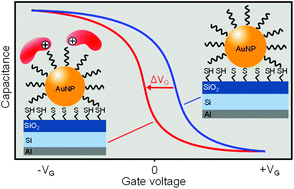Gating capacitive field-effect sensors by the charge of nanoparticle/molecule hybrids†
Abstract
The semiconductor field-effect platform is a powerful tool for chemical and biological sensing with direct electrical readout. In this work, the field-effect capacitive electrolyte–insulator–semiconductor (EIS) structure – the simplest field-effect (bio-)chemical sensor – modified with citrate-capped gold nanoparticles (AuNPs) has been applied for a label-free electrostatic detection of charged molecules by their intrinsic molecular charge. The EIS sensor detects the charge changes in AuNP/molecule inorganic/organic hybrids induced by the molecular adsorption or binding events. The feasibility of the proposed detection scheme has been exemplarily demonstrated by realizing capacitive EIS sensors consisting of an Al–p-Si–SiO2–silane–AuNP structure for the label-free detection of positively charged cytochrome c and poly-D-lysine molecules as well as for monitoring the layer-by-layer formation of polyelectrolyte multilayers of poly(allylamine hydrochloride)/poly(sodium 4-styrene sulfonate), representing typical model examples of detecting small proteins and macromolecules and the consecutive adsorption of positively/negatively charged polyelectrolytes, respectively. For comparison, EIS sensors without AuNPs have been investigated, too. The adsorption of molecules on the surface of AuNPs has been verified via the X-ray photoelectron spectroscopy method. In addition, a theoretical model of the functioning of the capacitive field-effect EIS sensor functionalized with AuNP/charged-molecule hybrids has been discussed.


 Please wait while we load your content...
Please wait while we load your content...